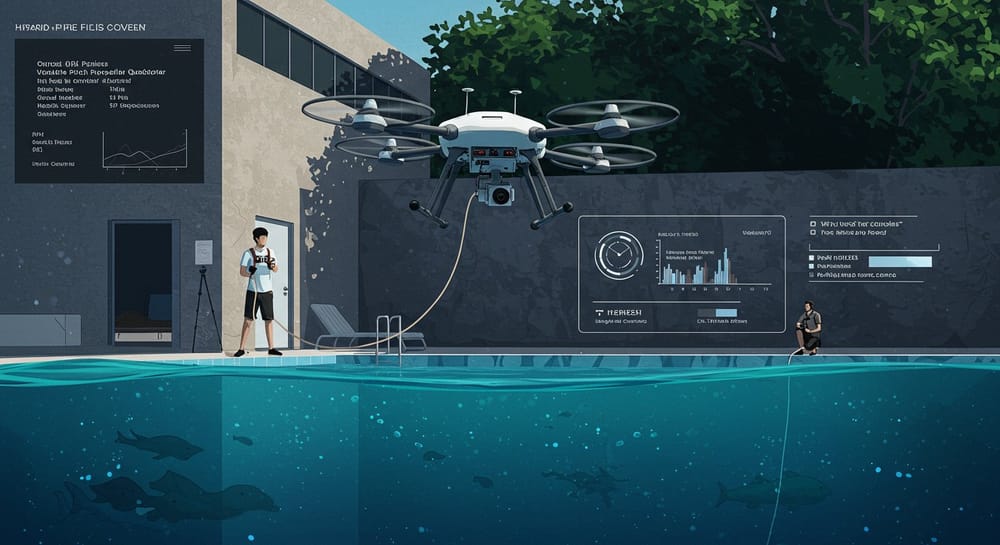Students Build Amazing Hybrid Drone That Flies AND Swims
Students Build Amazing Hybrid Drone That Flies AND Swims
Here's something you don't see every day – a drone that can literally dive into water and keep working perfectly. A group of undergraduate students just blew the robotics community away with their hybrid aerial-underwater drone that's making engineers everywhere wonder why nobody thought of this sooner.
The project, shared by Reddit user u/Skraldespande in the r/robotics community, shows off what might be the coolest bachelor's thesis project we've seen in years. And honestly? The video demonstration is absolutely mesmerizing.
How This Revolutionary Hybrid Drone Actually Works
So what makes this thing so special? Well, turns out the secret sauce is all in the propellers. The students used variable pitch propeller technology – basically, the drone can adjust its propeller angles on the fly (pun intended) to work efficiently both in air and underwater.
The technical breakdown is pretty impressive:
Variable pitch propellers that adapt to different environments 3D printed propeller blades (because why not make it even cooler) Custom flight control software that handles the transition Real-time monitoring of RPM and pitch for each propeller
But here's the thing – watching it in action is where this project really shines. The drone smoothly descends from hovering above a swimming pool, plunges into the water without missing a beat, navigates underwater like it was designed for it, then pops back up to the surface ready to fly again.
The Robotics Community Is Absolutely Loving This
The response from fellow robotics enthusiasts has been overwhelmingly positive. One user, Stretch5678, pretty much summed up everyone's reaction: "Okay, that's EPIC." And let's be honest, they're not wrong.
Other community members are already thinking about practical applications. User rorkijon raised some interesting technical questions about depth limitations and autonomous recovery systems, asking: "How deep could it go before you lose connectivity and rely on autonomous recovery to the surface?"
There's also the inevitable (and probably accurate) observation from ComeWashMyBack: "The US Military has entered the chat...." Because, let's face it, military applications for this kind of technology are pretty obvious.
Why This Matters for the Future of Drone Technology
This isn't just a cool student project – it's potentially a game-changer for multiple industries. Think about search and rescue operations, environmental monitoring, or marine research. Having a single platform that can seamlessly operate in both air and water opens up possibilities that were previously impossible or required multiple expensive pieces of equipment.
The fact that undergraduate students pulled this off using 3D printed components and custom software also shows how accessible advanced robotics development has become. As one commenter noted, "Things are getting real. Gotta make my next drone water proof."
Technical Innovation Behind the Scenes
What really impresses me about this project is the attention to detail in the execution. The video shows real-time data overlays displaying RPM and pitch information for each propeller, suggesting a sophisticated control system that's constantly optimizing performance based on the operating environment.
The variable pitch propeller system is particularly clever because it addresses the fundamental challenge of hybrid air-water vehicles: air and water have completely different density and flow characteristics. Traditional fixed-pitch propellers that work well in air are usually terrible underwater, and vice versa.
What's Next for Hybrid Drone Development?
Projects like this one are pushing the boundaries of what we consider possible in autonomous vehicle design. The seamless transition capability demonstrated here could inspire a whole new category of multi-environment drones.
I mean, think about it – if students can achieve this level of sophistication in a bachelor's thesis project, what could well-funded research teams or companies accomplish? We might be looking at the early stages of a major shift in how we approach drone design and deployment.
Frequently Asked Questions
How does a hybrid drone work underwater?
The drone uses variable pitch propellers that can adjust their angle to work efficiently in both air and water. The denser water requires different propeller settings than air flight.
What are the practical applications for aerial-underwater drones?
These hybrid drones could be used for search and rescue operations, marine research, environmental monitoring, underwater infrastructure inspection, and military reconnaissance.
How deep can hybrid drones operate underwater?
The operational depth depends on waterproofing, communication range, and battery life. Most hybrid drones are currently limited to shallow water operations due to communication constraints.
The robotics community is clearly excited about this innovation, and rightfully so. When students are creating technology this advanced for their thesis projects, it makes you wonder what professional development teams might accomplish next.
Source
Originally discussed by u/Skraldespande on r/robotics
Read the original post: Reddit Thread
This breakthrough in hybrid drone technology represents exactly the kind of innovation that's pushing robotics forward. And the fact that it came from undergraduate students? That's what makes it even more impressive.




